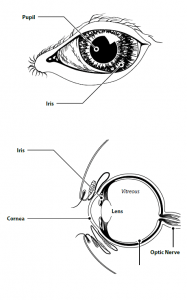The uvea is the major blood supply to the eye and is comprised of the iris, ciliary body, and choroid. These major structures of the eye are very sensitive and perform numerous functions required for ocular homeostasis and vision. Uveitis is inflammation of these structures and results in pain, cloudiness to the intraocular fluids, and in severe cases, blindness. Uveitis can occur for many reasons, and depending on what the ophthalmologist finds on your pet’s examination, they may be able to determine the most likely cause. Further diagnostics with blood tests, radiographs, or ultrasounds may be recommended. In severe cases with pain that is unresponsive to therapy, surgery may also be recommended.
Causes of Uveitis in Dogs & Cats
Causes of uveitis in dogs include:
- Tick born diseases such as Erhlichia, Rocky Mountain Spotted Fever, Rickettsia, and Lyme Disease
- Fungal infections such as Blastomycoses, Histoplasmosis, Cryptococcosis, or Coccidiomycosis
- Parasitic disease due to intestinal parasites or heartworm disease
- Neoplasia (cancer) of the eye, or cancer of another area of the body that has spread to the eye
- Immune-mediated (similar to Lupus or Rheumatoid arthritis in people), the body’s own immune system begins to attack the uvea, causing inflammation throughout the eye. This is a diagnosis of exclusion (rule out other causes) and usually responds well to treatment, but lifelong therapy is required to maintain control.
Causes of uveitis in cats include:
- Feline Leukemia Virus (FeLV), which cannot be spread to people
- Feline immunodeficiency virus (FIV, also known as feline AIDS), which cannot be spread to people
- Feline infectious peritonitis (FIP) disease complex caused by the coronavirus, which cannot be spread, to people
- Bartonellosis (Cat scratch fever) is caused by bacteria that can be spread to people, especially those that are young or immunosuppressed by other diseases or chemotherapy
- Toxoplasmosis is caused by a protozoal parasite that can be spread to people, especially those that are immunosuppressed by other diseases or chemotherapy
- Fungal infections such as Blastomycoses, Histoplasmosis, Cryptococcosis, or Coccidiomycosis
- Parasitic disease due to intestinal parasites or heartworm disease
- Neoplasia (cancer) of the eye, or cancer of another area of the body that has spread to the eye
- Idiopathic: Cause is unknown
Regardless of the cause, uveitis requires treatment to try to prevent secondary glaucoma, permanent blindness, and pain.
Important Points in Treatment of Uveitis in Dogs and Cats
- The cause of uveitis determines the recommended treatment
- Medications should be continued unless specifically instructed to discontinue them, even if you feel your pet is improving. Discontinuing medications too soon can cause a severe relapse of disease and secondary complications.
- Call immediately if your pet begins to show new symptoms with the eyes or systemically such as vomiting, diarrhea, or lethargy.
Diagnostics Recommended For Your Pet
Based on the ocular examination findings, the ophthalmologist recommends the following tests as part of your pet’s best care plan:
- Complete Blood Count (CBC): This is a blood test that evaluates red blood cell, white blood cell, and platelet counts to determine if they are abnormal related to your pet’s uveitis. If cancer is present in the bone marrow, it will also likely show up on this test.
- Chemistry Profile: This is a blood test that evaluates for severe liver and kidney disease as well as shows electrolyte and protein levels in the blood to determine if they are abnormal related to your pet’s uveitis.
- Tick titers: This is a blood test that evaluates for exposure to tick disease and determines if a tick-borne infection is likely the cause of your pet’s uveitis. This test is very sensitive to rule out tick-related disease.
- Fungal titers: This is a blood (and sometimes urine) test that supports whether the fungal infection is likely the cause of your pet’s uveitis. This test is very specific to diagnosing fungal infection, but sometimes there are false-negative results.
- Cancer screening: Radiographs of the chest and an abdominal ultrasound performed by a radiologist are the best tools for screening for cancer. If signs of cancer are found elsewhere in the body, samples can be taken non-invasively to help try to obtain a complete diagnosis, prognosis, and therapy options.
